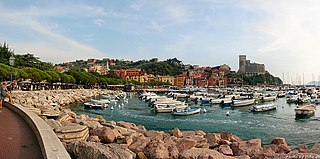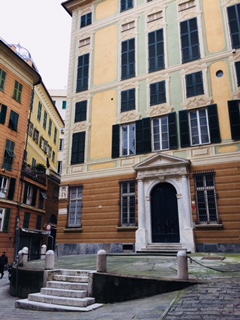
Pisa is a city and comune in Tuscany, central Italy, straddling the Arno just before it empties into the Ligurian Sea. It is the capital city of the Province of Pisa. Although Pisa is known worldwide for its leaning tower, the city contains more than twenty other historic churches, several medieval palaces, and bridges across the Arno. Much of the city's architecture was financed from its history as one of the Italian maritime republics.

Feodosia, also called in English Theodosia, is a port and resort, a town of regional significance in the Crimea on the coast of the Black Sea. Feodosia serves as the administrative center of Feodosia Municipality, one of the regions into which the Crimea is divided. During much of its history, the city was known as Caffa or Kaffa. According to the most recent census, in 2014, its population was 69,145 .

The Republic of Genoa was a medieval and early modern maritime republic from the 11th century to 1797 in Liguria on the northwestern Italian coast. During the Late Middle Ages, it was a major commercial power in both the Mediterranean Sea and the Black Sea. Between the 16th and 17th centuries it was one of the major financial centers in Europe.

Lerici is a town and comune in the province of La Spezia in Liguria, part of the Italian Riviera. It is situated on the coast of the Gulf of La Spezia, 8 kilometres (5 mi) southeast of La Spezia. It is known as the place where the poet Percy Bysshe Shelley drowned. The town is connected by ferry to the Cinque Terre and Portovenere.

Ligurian or Genoese is a Gallo-Italic language spoken primarily in the territories of the former Republic of Genoa, now comprising the area of Liguria in Northern Italy, parts of the Mediterranean coastal zone of France, Monaco, the village of Bonifacio in Corsica, and in the villages of Carloforte on San Pietro Island and Calasetta on Sant'Antioco Island off the coast of southwestern Sardinia. It is part of the Gallo-Italic and Western Romance dialect continuum. Although part of Gallo-Italic, it exhibits several features of the Italo-Romance group of central and southern Italy. Zeneize, spoken in Genoa, the capital of Liguria, is the language's prestige dialect on which the standard is based.
Genoese, locally called zeneise or zeneize[zeˈnejze], is the main Ligurian dialect, spoken in and around the Italian city of Genoa, the capital of Liguria, in Northern Italy.

Giovanni Luigi "Gianni" Brera was an Italian sports journalist and novelist. This is a description by himself: "My real name is Giovanni Luigi Brera. I was born on 8 September 1919 in San Zenone Po in the province of Pavia, and grew up like a wild man among woods, river banks and still waters. [...] I am a Padan from the banks and flood plains, the bush and the sandbanks. I soon realized I was a legitimate son of the Po".

Sassello is a comune (municipality) in the Province of Savona in the Italian region Liguria, located about 58 kilometres (36 mi) west of Genoa and about 26 kilometres (16 mi) north of Savona in the northern side of the Ligurian Apennines. It is the birthplace of Blessed Chiara Badano.

Giovanni Andrea Ansaldo was an Italian painter active mainly in Genoa.

The Delle Piane family is an old Genoese noble family first recorded in Polcevera in 1121. Over the past ten centuries it has produced many distinguished government officials, clerics, diplomats, soldiers and patrons.

Piazza De Ferrari is the main square of Genoa. Situated in the heart of the city between the historical and the modern center, Piazza De Ferrari is renowned for its fountain, which was restored in recent years along with a major restyling of the square.

The colonies of the Republic of Genoa were a series of economic and trade posts in the Mediterranean and Black Seas. Some of them had been established directly under the patronage of the republican authorities to support the economy of the local merchants, while others originated as feudal possessions of Genoese nobles, or had been founded by powerful private institutions, such as the Bank of Saint George.

The Royal Armoury of Turin is one of the world's most important collections of arms and armour, formed in Turin by the Savoy family. The museum is now part of the Musei Reali di Torino, the royal site that has unified the Royal Palace, the Sabauda Gallery, the Archaeological Museum, the Royal Library and the Armoury. The whole site has been included on the UNESCO World Heritage list since 1997.

Genoa is the capital of the Italian region of Liguria and the sixth-largest city in Italy. In 2015, 594,733 people lived within the city's administrative limits. As of the 2011 Italian census, the Province of Genoa, which in 2015 became the Metropolitan City of Genoa, had 855,834 resident persons. Over 1.5 million people live in the wider metropolitan area stretching along the Italian Riviera.

The Battle of Pianosa was a naval engagement which took place on 25 April 25, 1519, when a Genoese fleet severely defeated the flotilla of the Tunisia-based Barbary corsair Kaid Ali in the Tyrrhenian Sea, in view of the island of Elba. The battle broke the back of one of the rising corsair bases on the Barbary Coast, Bizerte, and established Andrea Doria as among the foremost captains in the Mediterranean.

The Palazzo Clemente della Rovere is a palace located in Piazza Rovere in the historical center of Genoa, Northwestern Italy. The palace was one of the 163 Palazzi dei Rolli of Genoa, the selected private residences where the notable guests of the Republic of Genoa were hosted during State visits. On 13 luglio 2006 it was added to the list of 42 palaces which now form the UNESCO World Heritage Site Genoa: Le Strade Nuove and the system of the Palazzi dei Rolli. The palace hosts today the General Consulate of Iceland.
Manegoldo del Tettuccio was an Brescian politician, and the first Podestà of the Republic of Genoa, elected in 1191.

Ligurian cuisine consists of dishes from the culinary tradition of Liguria, a region of northwestern Italy, which makes use of ingredients linked both to local production, and to imports from areas with which, over the centuries, the Ligurians have had frequent trade.
Silvio Parodi was an Italian Fascist politician and soldier.

Giuseppe Isola was an Italian painter.